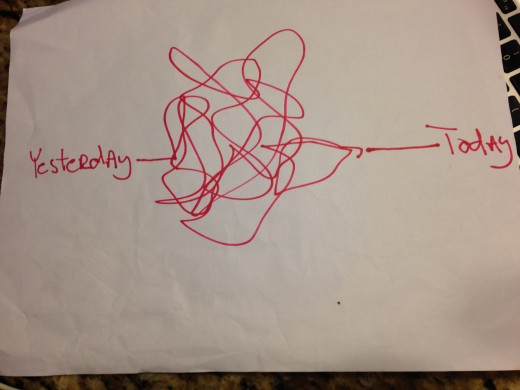Apathy in the Work Place
Is it really worth it?

Bizarre Times, Bizarre People
Herman Melville's "Bartleby the Scrivener" is a short story based on the lives of law copyists. Set in mid 1850s Manhattan, Bartleby is told from the perspective of a law-copying manager.
Melville portrays the characters in a way that suggests the working conditions are unusual. Using imagery and vivid descriptions of behavior adds to the effect of the somewhat perplexing story.
In the end of the story, nothing is truly resolved. The reader is left wondering what each character's motive is and how his behavior is justified.
Ever Have A Day Like This?

It Takes All Kinds
One of the factors contributing to the effect of the story is the clever use of imagery to describe an individual or situation. For example, the windows that "commanded an unobstructed view of a lofty brick wall", paint a troubling image of substandard working conditions. This image reflects how oppressive the work place was at the time the story was written.
Melville is also effective using imagery to describe the narrator's co-workers, Turkey, Nippers, Ginger Nut and the story's passive antagonist Bartleby. Also, the structure of the story (having it broken down into separate character sketches before the plot unfolds) enhances the differences between the narrator's employees.
The "florid hue", in Turkey's complexion changes after he returns from his lunch break. A fiery red complexion may be an indication of excessive drinking, which is confirmed by Melville, as Turkey's efforts in his law office become "...seriously disturbed for the remainder of the twenty-four hours" after he returns to the office.
Too Much Slack
Besides imagery, Melville also uses character descriptions in an effort to present the bizarre behavior of the narrator's employees. In Nipper's case, his "diseased ambition" is manifested through his shady relationships with clients with criminal records.
It is also perplexing that the narrator allows lax standards at the work place because when "Nippers was on, Turkey was off; and vice versa". Besides the precocious Ginger Nut, the youngest employee, everyone in the law office leaves much to be desired.
Employees such as Turkey and Nippers would typically be fired if they worked for and other law office. This may be because the narrator seems to tolerate bizarre behavior.
The text mentions that the narrator is a man with a "profound condition that the easiest way of life is best". However, being gracious to a fault with his employees is the reason incompetent people work for him.
The narrator, who comes off as a dignified person, has a serious inability to properly understand what the motives of his employees are, as well as, how to control them.
The De Facto Hero Emerges
Bartleby's behavior is even more mysterious than his co-workers. Initially, Bartelby was prolific as a scrivener and worked "silently, palely, mechanically", to the delight of his boss. However, Bartleby is standoffish and works in isolation, never collaborating with his co-workers, when asked to.
As the story progresses, it appears that something has changed Bartleby. Perhaps it is the monotony of the copying that has affected him; it may be that his previous work as a Dead Letter carrier has left him emotionless, which is understandable.
Whatever the case, his passive resistance to work displays just how apathetic the nature of his work has made him. Whenever his superior asks him to perform the simplest of tasks, such as providing his co-workers with legal copies, or sharing ideas, Bartleby peacefully declines, claiming that he "would prefer not to".
Despite this insubordination, the narrator becomes fascinated with Bartleby's behavior and goes to great lengths to help him.
Mirror Image
The use of imagery and in-depth character descriptions leaves the reader with more questions than answers. There is also a strange dynamic between the narrator and Bartleby. The narrator becomes deeply involved with Bartleby's situation mainly because he sees something in himself through Bartleby.
Having come to the realization that being passive is best, the narrator almost has to excuse Bartleby for his imperfections. By extension, Melville suggests that Bartleby is a reflection of how all humans are imperfect.








